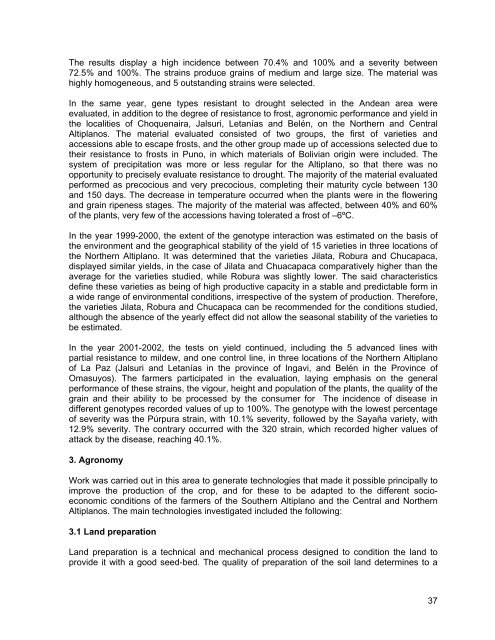Study on the social, environmental and economic impacts of quinoa ...
Study on the social, environmental and economic impacts of quinoa ...
Study on the social, environmental and economic impacts of quinoa ...
Create successful ePaper yourself
Turn your PDF publications into a flip-book with our unique Google optimized e-Paper software.
The results display a high incidence between 70.4% <strong>and</strong> 100% <strong>and</strong> a severity between<br />
72.5% <strong>and</strong> 100%. The strains produce grains <strong>of</strong> medium <strong>and</strong> large size. The material was<br />
highly homogeneous, <strong>and</strong> 5 outst<strong>and</strong>ing strains were selected.<br />
In <strong>the</strong> same year, gene types resistant to drought selected in <strong>the</strong> Andean area were<br />
evaluated, in additi<strong>on</strong> to <strong>the</strong> degree <strong>of</strong> resistance to frost, agr<strong>on</strong>omic performance <strong>and</strong> yield in<br />
<strong>the</strong> localities <strong>of</strong> Choquenaira, Jalsuri, Letanías <strong>and</strong> Belén, <strong>on</strong> <strong>the</strong> Nor<strong>the</strong>rn <strong>and</strong> Central<br />
Altiplanos. The material evaluated c<strong>on</strong>sisted <strong>of</strong> two groups, <strong>the</strong> first <strong>of</strong> varieties <strong>and</strong><br />
accessi<strong>on</strong>s able to escape frosts, <strong>and</strong> <strong>the</strong> o<strong>the</strong>r group made up <strong>of</strong> accessi<strong>on</strong>s selected due to<br />
<strong>the</strong>ir resistance to frosts in Puno, in which materials <strong>of</strong> Bolivian origin were included. The<br />
system <strong>of</strong> precipitati<strong>on</strong> was more or less regular for <strong>the</strong> Altiplano, so that <strong>the</strong>re was no<br />
opportunity to precisely evaluate resistance to drought. The majority <strong>of</strong> <strong>the</strong> material evaluated<br />
performed as precocious <strong>and</strong> very precocious, completing <strong>the</strong>ir maturity cycle between 130<br />
<strong>and</strong> 150 days. The decrease in temperature occurred when <strong>the</strong> plants were in <strong>the</strong> flowering<br />
<strong>and</strong> grain ripeness stages. The majority <strong>of</strong> <strong>the</strong> material was affected, between 40% <strong>and</strong> 60%<br />
<strong>of</strong> <strong>the</strong> plants, very few <strong>of</strong> <strong>the</strong> accessi<strong>on</strong>s having tolerated a frost <strong>of</strong> –6ºC.<br />
In <strong>the</strong> year 1999-2000, <strong>the</strong> extent <strong>of</strong> <strong>the</strong> genotype interacti<strong>on</strong> was estimated <strong>on</strong> <strong>the</strong> basis <strong>of</strong><br />
<strong>the</strong> envir<strong>on</strong>ment <strong>and</strong> <strong>the</strong> geographical stability <strong>of</strong> <strong>the</strong> yield <strong>of</strong> 15 varieties in three locati<strong>on</strong>s <strong>of</strong><br />
<strong>the</strong> Nor<strong>the</strong>rn Altiplano. It was determined that <strong>the</strong> varieties Jilata, Robura <strong>and</strong> Chucapaca,<br />
displayed similar yields, in <strong>the</strong> case <strong>of</strong> Jilata <strong>and</strong> Chuacapaca comparatively higher than <strong>the</strong><br />
average for <strong>the</strong> varieties studied, while Robura was slightly lower. The said characteristics<br />
define <strong>the</strong>se varieties as being <strong>of</strong> high productive capacity in a stable <strong>and</strong> predictable form in<br />
a wide range <strong>of</strong> envir<strong>on</strong>mental c<strong>on</strong>diti<strong>on</strong>s, irrespective <strong>of</strong> <strong>the</strong> system <strong>of</strong> producti<strong>on</strong>. Therefore,<br />
<strong>the</strong> varieties Jilata, Robura <strong>and</strong> Chucapaca can be recommended for <strong>the</strong> c<strong>on</strong>diti<strong>on</strong>s studied,<br />
although <strong>the</strong> absence <strong>of</strong> <strong>the</strong> yearly effect did not allow <strong>the</strong> seas<strong>on</strong>al stability <strong>of</strong> <strong>the</strong> varieties to<br />
be estimated.<br />
In <strong>the</strong> year 2001-2002, <strong>the</strong> tests <strong>on</strong> yield c<strong>on</strong>tinued, including <strong>the</strong> 5 advanced lines with<br />
partial resistance to mildew, <strong>and</strong> <strong>on</strong>e c<strong>on</strong>trol line, in three locati<strong>on</strong>s <strong>of</strong> <strong>the</strong> Nor<strong>the</strong>rn Altiplano<br />
<strong>of</strong> La Paz (Jalsuri <strong>and</strong> Letanías in <strong>the</strong> province <strong>of</strong> Ingavi, <strong>and</strong> Belén in <strong>the</strong> Province <strong>of</strong><br />
Omasuyos). The farmers participated in <strong>the</strong> evaluati<strong>on</strong>, laying emphasis <strong>on</strong> <strong>the</strong> general<br />
performance <strong>of</strong> <strong>the</strong>se strains, <strong>the</strong> vigour, height <strong>and</strong> populati<strong>on</strong> <strong>of</strong> <strong>the</strong> plants, <strong>the</strong> quality <strong>of</strong> <strong>the</strong><br />
grain <strong>and</strong> <strong>the</strong>ir ability to be processed by <strong>the</strong> c<strong>on</strong>sumer for The incidence <strong>of</strong> disease in<br />
different genotypes recorded values <strong>of</strong> up to 100%. The genotype with <strong>the</strong> lowest percentage<br />
<strong>of</strong> severity was <strong>the</strong> Púrpura strain, with 10.1% severity, followed by <strong>the</strong> Sayaña variety, with<br />
12.9% severity. The c<strong>on</strong>trary occurred with <strong>the</strong> 320 strain, which recorded higher values <strong>of</strong><br />
attack by <strong>the</strong> disease, reaching 40.1%.<br />
3. Agr<strong>on</strong>omy<br />
Work was carried out in this area to generate technologies that made it possible principally to<br />
improve <strong>the</strong> producti<strong>on</strong> <strong>of</strong> <strong>the</strong> crop, <strong>and</strong> for <strong>the</strong>se to be adapted to <strong>the</strong> different socioec<strong>on</strong>omic<br />
c<strong>on</strong>diti<strong>on</strong>s <strong>of</strong> <strong>the</strong> farmers <strong>of</strong> <strong>the</strong> Sou<strong>the</strong>rn Altiplano <strong>and</strong> <strong>the</strong> Central <strong>and</strong> Nor<strong>the</strong>rn<br />
Altiplanos. The main technologies investigated included <strong>the</strong> following:<br />
3.1 L<strong>and</strong> preparati<strong>on</strong><br />
L<strong>and</strong> preparati<strong>on</strong> is a technical <strong>and</strong> mechanical process designed to c<strong>on</strong>diti<strong>on</strong> <strong>the</strong> l<strong>and</strong> to<br />
provide it with a good seed-bed. The quality <strong>of</strong> preparati<strong>on</strong> <strong>of</strong> <strong>the</strong> soil l<strong>and</strong> determines to a<br />
37

















